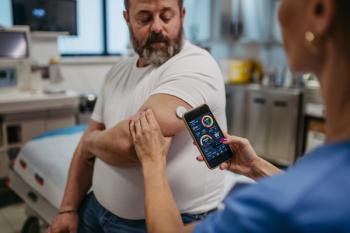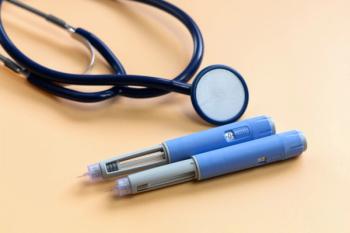
- October 2013 Diabetes
- Volume 79
- Issue 10
Becoming a Diabetes Expert: Walk the Walk
A guide to mastering new skills for diabetes patient care in just 10 steps.
Those who want to master new skills for diabetic patient care are just 10 steps away.
Two pharmacists sat next to each other at a conference: an (insufferable) diabetes expert and a second, non-expert, mired in a midlife career. The diabetes expert, clearly self-impressed, talked about his thriving practice. He said he enjoyed flexible hours and constant challenges. He left to circulate, and the other pharmacist thought, “I’d like to be a diabetes expert, but it’s too late for me. I’m stuck. I’ve been a retail pharmacist for 20 years.”
Nothing is further from the truth. Do you have a similar dream?
Pre-contemplation
Our retail pharmacist needs a change. Maybe you do, too? Settled in the pre-contemplation stage of change, she wasn’t actively considering or ready to change. Change is possible. Hopefully she—and maybe you—will move into the contemplative stage, and then into the preparation and action stages.1,2
As you contemplate developing an expertise in diabetes—or any other specialty—realize that mastering specialty skills requires more than acquiring more knowledge. Specialists fundamentally differ from generalists: their world view and approach are more intuitive than rule-based.
They meld their vast collection of facts and experiences to recognize patterns, extract the bits that are most important, and become an involved part of the problem and process rather than an observer. For diabetes experts, this means partnering with the patient and taking partial responsibility for results.3
Once you’re ready to become an expert, it’s critical to prepare and plan.2
#1. Identify obstacles and commit. For most of us, time is a huge obstacle. Often, choosing a date, time, and place to pursue a goal can help us make steady progress. Try to commit to at least 2 hours a week. Actually writing the “appointments” on your calendar can help. Initially, you’ll gather information (Step #2 below). The Table describes key elements of preparation.
#2. Identify resources. To become a diabetes expert, you will need to know diabetes’ epidemiology, pathology, treatment, common complications, adherence issues, and financing. You must know how to use devices, products, and equipment. You will need an understanding that transcends rules and guidelines. A good place to start is the National Diabetes Education program (NDEP) website (
There are numerous ways to proceed. You can find a mentor or a study partner. Having a person to whom you are accountable can keep you on task. If you approach someone to mentor you, be sure that you like and can communicate with that person. Next, begin looking for educational materials. Think broadly. You can receive a good education from online courses, conferences, and continuing education events.
Acting on the Dream
#3. Join a multidisciplinary professional association. The American Association of Diabetes Educators (AADE) is the leading organization in this field. On its site, you can find accredited diabetes programs near you, and diabetes educators. (Hint: You might contact a certified diabetes educator near you to be your mentor.) The AADE also offers a wealth of professional resources. You’ll need to know the legal, ethical, and business rules and regulations associated with being a field expert. The AADE’s Guidelines for the Practice of Diabetes Self-Management Education and Training can introduce these topics.
#4. Live for 7 to 31 days as a diabetic. Nothing educates like simulation programs, especially when the target condition requires significant lifestyle modifications and schedule adaptations. Make yourself a case study of a type 1 or type 2 diabetic who has a common comorbidity or 2, and create a care plan. Then, live it. Set up a medication schedule and use candy (make it sugar-free, please) instead of oral dosage forms, and take breaks to meditate when you are due for an insulin injection (some student programs inject saline). Follow an appropriate diabetic diet. Record your insights in a journal.6,7
#5. Practice, practice, practice. Make it a goal to counsel a few diabetic patients every day. It only takes a few minutes. Encourage them to talk. Ask questions, and your patients will educate you and help you develop intuition and insight. Ask patients how closely they follow their glycated hemoglobin level, how they manage their diet, if they have identified helpful products, etc.8,9
#6. Get certified. Visit the National Certification Board for Diabetes Educators (NCBDE;
Maintaining the Credential
#7. Stay current. Once you’ve become certified, you’ll need to maintain and possibly expand your skills. In addition to watching the news and fulfilling continuing education obligations, look for blogs, social networks, and listservs that cater to your new interest (being careful to protect patient confidentiality). Also watch for new and helpful apps—be sure to try them yourself before recommending them to patients.10-12
#8. Volunteer. After certification, you may want to develop an independent practice. Advertising is a good way to let people know you’re available, but it can be expensive. Volunteering can also bring your skills to potential patients’ attention. Write short articles for a local paper, attend brown bag lunches, or create and maintain your own blog. A warning here, however: Volunteer because you care about people and your new vocation, and do not actively promote or solicit for your business. Your expertise and enthusiasm is all the advertising you need. Volunteering is cultivating relationships.
#9. Give it time. It takes time to progress from novice to expert. It requires a complex combination of book knowledge, training, experience, and application. Having been through the stages of change to achieve your goal, you’ll have more insight into how difficult change is for diabetics and perhaps a few tips to help them.2,13
#10. Hang out your shingle! Know that physicians rarely have time to help patients with the basics of diabetes care, so your expertise is needed. As you gain confidence, let people know about your credentials. Put it on your resume. Make a sign for your work place. Mentor students from a nearby university. Celebrate your success.
But please, don’t become insufferable!
Ms. Wick is a visiting professor at the University of Connecticut School of Pharmacy and a freelance clinical writer.
References
1. UCLA Center for Human Nutrition. Prochaska and DiClemente’s stages of change model. www.cellinteractive.com/ucla/physcian_ed/stages_change.html. Accessed July 1, 2013.
2. Norcross JC, Krebs PM, Prochaska JO. Stages of change. J Clin Psychol. 2011;67:143-154.
3. Litemind. How to become an expert: a roadmap. http://litemind.com/expert-roadmap/. Accessed July 1, 2013.
4. Dreyfus HL, Dreyfus SE. Mind Over Machine: The Power of Human Intuition and Expertise in the Age of the Computer. New York, NY: Simon & Schuster; 1986.
5. Wick JY. Supervision: A Pharmacy Perspective. 2003.
6. Sterrett J, Croom M, Phillips CM, Shrader S. Incorporating a diabetes certificate program in a pharmacy curriculum. Am J Pharm Educ. 2012;76:89.
7. Delea D, Shrader S, Phillips C. A week-long diabetes simulation for pharmacy students. Am J Pharm Educ. 2010;74(7):article 130.
8. Rodgers PT. Helping patients with diabetes: resources from the National Diabetes Education Program. J Am Pharm Assoc. 2012;52:e277-e281.
9. Nishita C, Cardazone G, Uehara DL, Tom T. Empowered diabetes management: life coaching and pharmacist counseling for employed adults with diabetes [published online November 21, 2012]. Health Educ Behav.
10. Greene JA, Choudhry NK, Kilabuk E, Shrank WH. Online social networking by patients with diabetes: a qualitative evaluation of communication with Facebook. J Gen Intern Med. 2011;26:287-292.
11. Nordfeldt S, Angarne-Lindberg T, Nordwall M, Ekberg J, Berterö C. As facts and chats go online, what is important for adolescents with type 1 diabetes? PLoS One. 2013;8:e67659.
12. Boyce N. The Lancet Technology: June, 2012. Maps, apps--and evidence? Lancet. 2012;379:2231.
13. Brody RA, Byham-Gray L, Touger-Decker R, Passannante MR, O'Sullivan Maillet J. Identifying components of advanced-level clinical nutrition practice: a Delphi study. J Acad Nutr Diet. 2012;112:859-869.
Articles in this issue
about 12 years ago
Pet Peevesabout 12 years ago
Case Studiesabout 12 years ago
Diabetes Specialized Medication Therapy Managementabout 12 years ago
Can You Read These Rxs?about 12 years ago
Dangerous Liaisons: Obesity and Diabetesabout 12 years ago
Type 2 Diabetesabout 12 years ago
Opportunities for Improving Outcomes with Insulin Injectionsabout 12 years ago
Health App WrapNewsletter
Stay informed on drug updates, treatment guidelines, and pharmacy practice trends—subscribe to Pharmacy Times for weekly clinical insights.


















































































































































































































